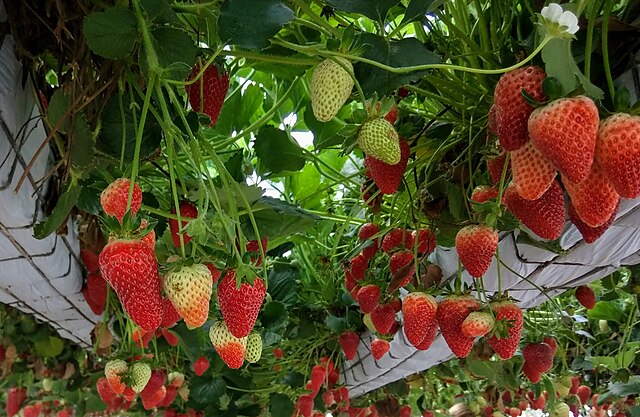Collection: Strawberry Plants
Planting Directions:
- Site Selection: Choose a location with full sun and well-drained soil. Strawberries prefer slightly acidic soil with a pH between 5.5 and 6.8.
- Soil Preparation: Amend the soil with organic matter such as compost to improve fertility and drainage.
- Planting Time: Plant strawberries in early spring as soon as the soil is workable. In warmer climates, they can also be planted in the fall.
- Spacing: Space strawberry plants about 18 inches apart in rows that are 3-4 feet apart. This allows for adequate air circulation and room for runners to spread. - Planting Depth: Plant strawberries so that the crown is at soil level. Avoid burying the crown as it can lead to rot.
Care and Maintenance:
- Watering: Keep the soil consistently moist, especially during fruiting. Avoid overhead watering to reduce the risk of disease.
- Mulching: Apply mulch to conserve moisture, suppress weeds, and protect the fruit from soil contact.
- Fertilization: Fertilize with a balanced fertilizer in early spring and again after the first harvest.
- Pest and Disease Control: Monitor for common pests like slugs and aphids, and diseases such as powdery mildew. Use appropriate organic or chemical controls as needed.
Uses of Strawberries:
- Culinary Uses: Strawberries are versatile and can be used fresh in salads, desserts, smoothies, and as a topping for cereals and yogurt. They can also be preserved as jams, jellies, and sauces.
- Nutritional Benefits: Strawberries are rich in vitamin C, antioxidants, and fiber, making them a healthy addition to the diet.
- Ornamental Uses: Strawberry plants can be used as ground cover or in hanging baskets for decorative purposes due to their attractive foliage and flowers.

-
 Sold out
Sold outAC Wendy Strawberry (25 Plants)
Regular price $25.00 USDRegular priceUnit price / per -
 Sold out
Sold outHoneoye Strawberry (25 Plants)
Regular price $25.00 USDRegular priceUnit price / per -
 Sold out
Sold outOzark Beauty Strawberry (25 Plants)
Regular price $25.00 USDRegular priceUnit price / per -
 Sold out
Sold outSparkle Strawberry (25 Plants)
Regular price $25.00 USDRegular priceUnit price / per -
 Sold out
Sold outWhite Carolina Pineberry (25 Plants)
Regular price $25.00 USDRegular priceUnit price / per




